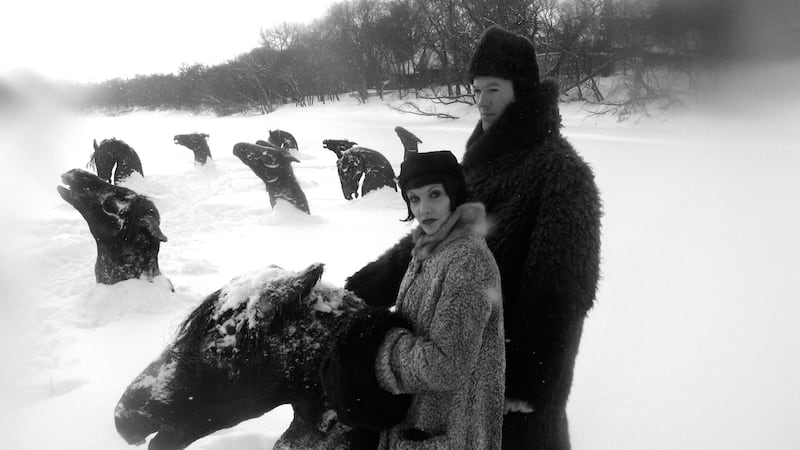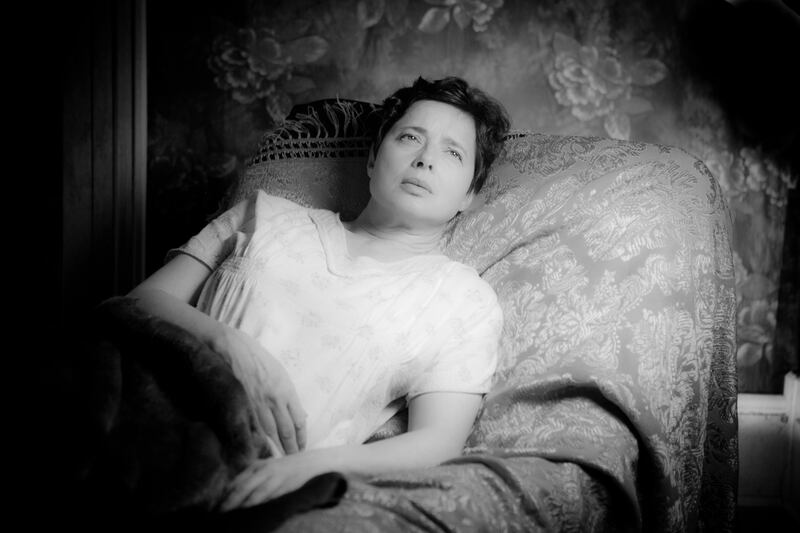In Paris a few years ago, as part of his Seances project, the singular cineaste and film artist Guy Maddin would gather together actors and a medium to hold hands and summon the plot of a long-lost silent film. For one of these “ciné-séances” the participants were Luce Vigo, daughter of Jean Vigo, and Geraldine Chaplin, daughter of the similarly indelible Charlie Chaplin, who came together to re-enact Lines of the Hand, one of Jean Vigo’s unrealised scripts.
“Charlie Chaplin was Jean Vigo’s favourite film-maker by far. Luce was in her 80s at the time, and she was a lovely lady with an apartment full of Charlie Chaplin memorabilia and toys and posters,” says Maddin, who is the subject of a retrospective at the upcoming Dublin International Film Festival. “And Geraldine, she’s still a little seven-year-old orphaned girl, even now. She has her own inscrutable connection with her father… I got them to just join hands. And I looked through the camera at these two legends – and daughters of legends – and I realised they were weeping profusely.
“I’m not going to pretend that the ghosts of Charlie Chaplin and Jean Vigo came down. But if you view a ghost as an ardent memory, which I do, then spirits were present that day. And damned if I didn’t choke up a bit – although later I told myself that I was choking up out of pride, as I was so damn proud of myself for conspiring to get these two women together.”
[ The Forbidden Room review: All the phantasmagoria you can handleOpens in new window ]
Maddin’s work, which simultaneously evokes silent cinema and surrealism, is experimental in the most fun sense of the word: The Heart of the World, from 2000, condensed the principles of Russian constructivism and a swooning apocalyptic romance into six minutes – with about 100 shots a minute to accommodate the feature-length story. The Saddest Music in the World, from 2003, starred Isabella Rossellini as a brewery magnate who stages the international contest of the title – and whose glass legs are filled with beer. The Green Fog reshaped Hitchcock’s Vertigo into a San Francisco travelogue.
READ MORE
David Lynch’s Eraserhead and Luis Buñuel’s L’Age d’Or have been recognisable touchstones since his feature debut, Tales from the Gimli Hospital. His playful, phantasmagoric, psychosexual tales of Soviet supermen, unrequited love, cannibalism, Arctic tundra, amnesia, prosthetics and ice hockey have been enlivening festivals and arthouse cinemas ever since. “My first feature probably had a walkout rate of 60 per cent,” Maddin says cheerfully. “With my second I managed to get the walkout rate up to about 85 per cent. Nowadays the walkout rates are virtually zero, because people going to the movies know they’re getting a Guy Maddin movie.”

Maddin’s native Winnipeg, a city he has characterised as “the world capital of sorrow”, makes for a remarkable playpen. In 2002, working with the Royal Winnipeg Ballet, the director adapted Bram Stoker’s most famous creation into Dracula: Pages from a Virgin’s Diary. Five years later, My Winnipeg, a hilariously unreliable memoir and cultural history that features in the Dublin retrospective, featured the actor Darcy Fehr as “Guy Maddin”. Fehr also played “Guy Maddin” in Maddin’s film Cowards Bend the Knees, as a 1930s hockey player who loses his lover in a backstreet abortion only to fall in love with her ghost.
“I’m actually kind of proud of Cowards Bend the Knee,” Maddin says. “I know it’s got its alienating effects. It’s shot on Super 8. It’s a silent movie. It’s out of focus. There was something wrong with my camera, but there was no way I was going to reshoot any of it. Even my intertitles, the easiest thing to shoot, came back blurry. But I had no money for sets or anything anyway, so sharpening the focus would have just revealed what a two-bit operation the whole production was.
With my second film I managed to get the walkout rate up to about 85%. Nowadays the walkout rates are virtually zero
“Anyway, by my standards the script was pretty good. The reason is that I borrowed all of its structure from Euripides’ Electra. I intentionally sought out classical literature as support for my movies because a lot of people say they like the style of the films but the scripts are incomprehensible. So I had these 2,500-year-old timbers, which seem like they’ll be good for another 2,500 years, at least, and overlaid them with autobiographical hysteria.”

Cowards Bend the Knee earned some of the best reviews of Maddin’s career. The former Village Voice critic J Hoberman called it the director’s masterpiece. Not everyone, as Maddin notes, was a fan.
“I went to a Q&A in a lovely theatre in New York,” the film-maker says. “A woman sitting in the front row put up her hands and said, ‘Do you think life is like this?’ I was going to start qualifying, but she got up and walked out at that point. I guess she felt that the movie was pretty cynical. Or maybe she was being literal-minded and thought I believe that life was full of intertitles.”
Maddin’s family history casts a perceptible shadow across his work. His father was the manager of the Maroons, a Winnipeg hockey team; the sport is referenced in Cowards Bend the Knee, My Winnipeg and beyond. Tales from Gimli Hospital features his Aunt Lil and was shot in his childhood home. Autobiography, Maddin says, crept in by accident.
“By the time I made my third feature, Careful, I felt like I had run out of ideas,” he says. “I didn’t have daddy issues, but I had many superintense responses to things that had happened in the world. When I came up with the idea of calling my protagonist Guy Maddin, I hadn’t written the character as Guy Maddin. I had given the name to a hockey player I loved growing up. He had such a strange name, a kind of a feminine name: Fran Huck.
There was something wrong with my camera. Even my intertitles, the easiest thing to shoot, came back blurry
“I thought that would be my autobiographical intrusion: this favourite hockey player. And then I said, ‘Wait a minute, what if he has a highly litigious lawyer?’ So I just put my name in – and as soon I did I suddenly felt far more obliged to vomit up even more heinous acts and characteristics from my life. I could be brave because I was profiting from this. I tapped into all these behaviours and how I would behave in certain situations and my most shameful moments. Just by calling a character Guy Maddin I could access stuff that I could never have dreamed up. That was a pretty productive period for me. I was even adding elements of myself to my ballet version of Dracula, because there’s so much male jealousy in there, and as a younger man I was jealous of everything. I was able to dial up the jealousy and misogyny in Dracula. It’s all there in the choreography.”

In recent years Maddin has expanded his repertoire into galleries, installations and augmented reality. The Seances website randomly shuffles clips into new films, each to be seen once only; as soon as a combination has been watched it will disappear forever. Cowards and My Winnipeg have been revisited and expanded into literature.
[ Sundance: Kneecap film wins audience award at US festivalOpens in new window ]
“I was trying to be practical for the first time in my life, because I’ve been wilfully making movies that I just felt like making. And they would get some critical success, which always felt great, but they would never penetrate the box office. I thought I could diversify the platforms. I thought of making films as an installation, which I did with the movie The Forbidden Room. I was approached by the wonderful people at the London Film Festival about augmented reality. So that was another platform on which to try my shtick. It turns out that I’m comfortable with just pretending that a lot of people care about my movies. But I have become a better teacher by trying new things. I have to teach to support myself between projects. And I’ve discovered through teaching what the hell it is I’ve been doing all these decades.”
Green Fog, My Winnipeg, Archangel and Brain Upon the Brain will be screening at this year’s Dublin International Film Festival, which runs from Thursday, February 22nd, to Saturday, March 2nd. Guy Maddin will take part in a Q&A after My Winnipeg with his fellow film-maker Tadhg O’Sullivan

















